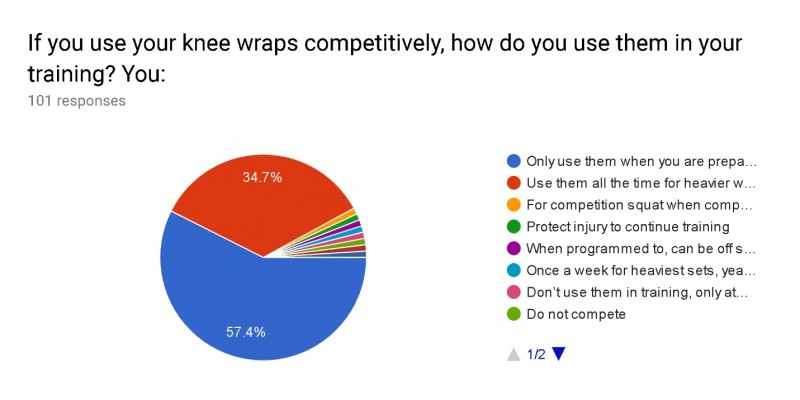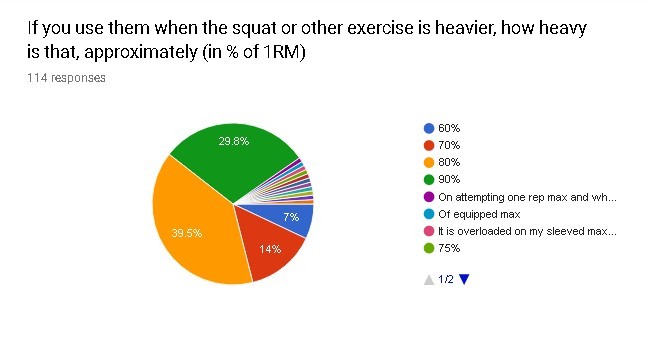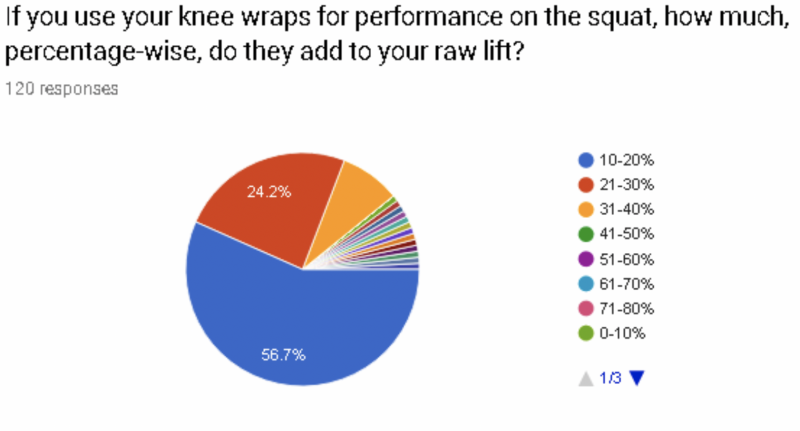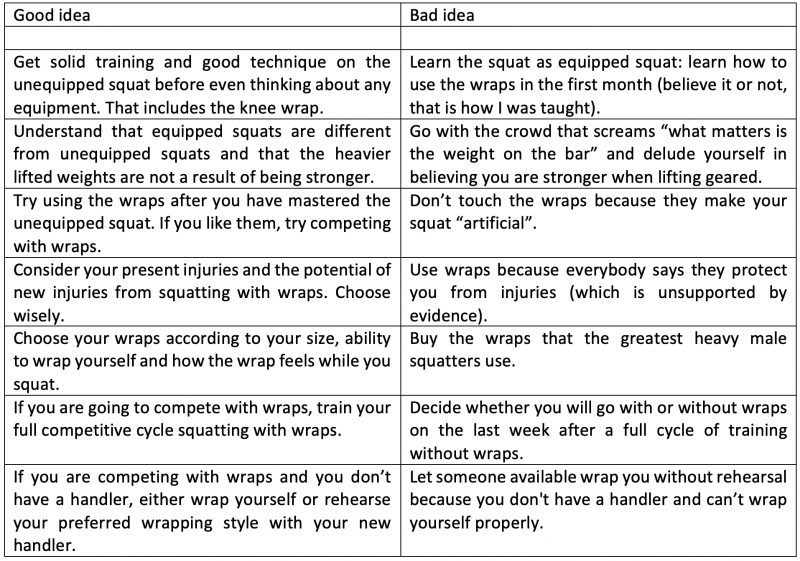
Unlike the belt or the wrist wrap, introduced in the past two articles of this series, the knee wrap is an object of controversy. There is some research about its mechanism of action but certainly not enough to make any conclusive claim. Meanwhile, in the sports world, specifically in the tiny sport of powerlifting, it is a matter of heated debate, love and hate, blood and tears. The knee wraps lie in the fine red line that separates the world of “raw” (or unequipped”) lifting and equipped lifting. Seven years ago I wrote something about the futility of this controversy and I believe my views have changed very little.
This is when I introduce the reader to the layer of issues hidden under the technical ones concerning personal equipment. The only pertinent fact here is that personal equipment that falls into the category of “supportive gear” change the execution of the movement and provides a “carry-over-effect” (additional weight lifted with the help of the equipment). The only sport where this happens is powerlifting, where it makes sense to separate competitions according to the equipment allowed on the platform. This “emotional/moral” layer will be completely ignored in this series.
Basics About the Knee Wrap
Summary chart:
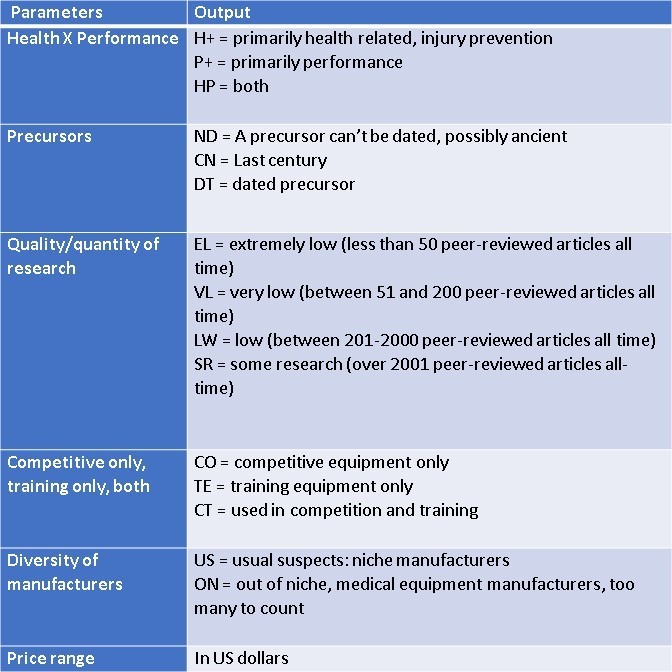
What Does a Knee Wrap Look Like?
This is part of the collection I had:
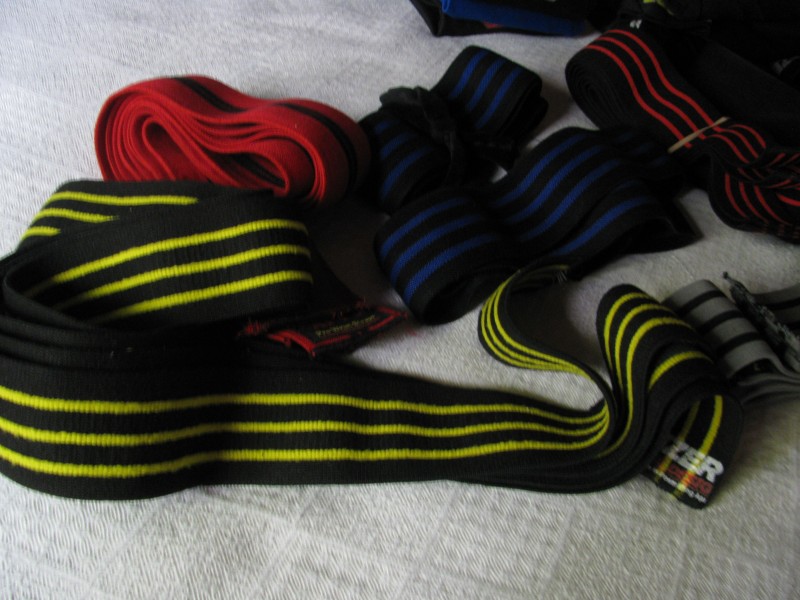
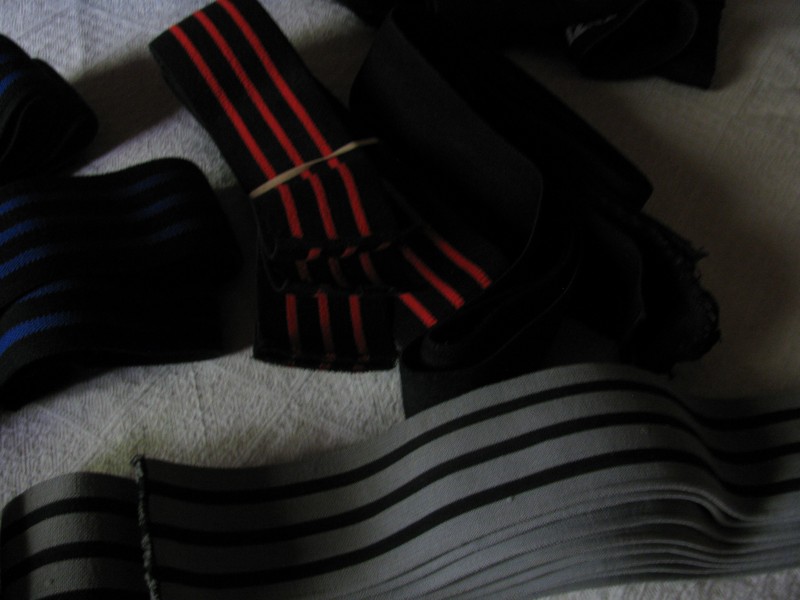
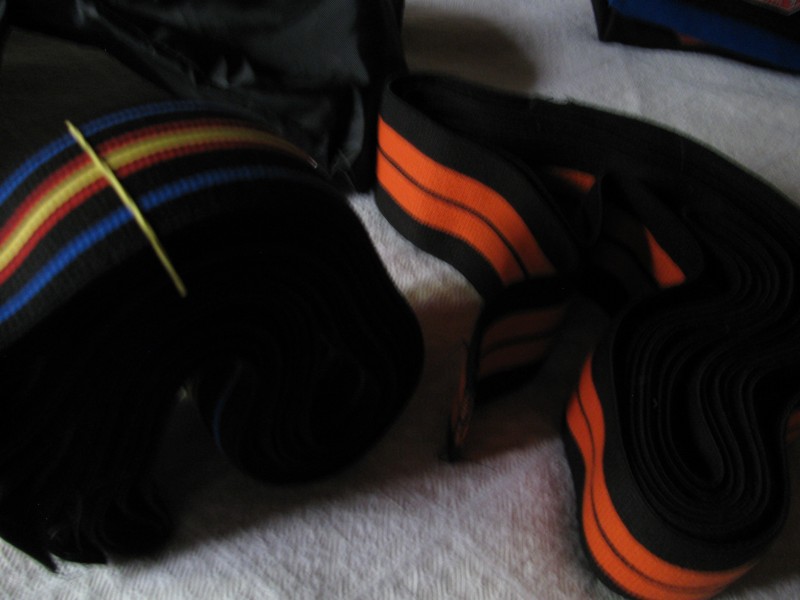
I owned over 40 knee wraps of different brands, models and lengths, tested some and regularly used a few. The pictures show a small part of that collection.
During my recovery from ACL reconstruction surgery in 2009, I used a very soft, blue APT wrap for safety as I reacquired squat movement patterns, coordination, and range of motion.
In my equipped competition years, I had the chance of testing some of the most coveted wraps in the world. At the top of the list was the APT strangulator: the grey, thick, spongy wrap used by Andrey Malanichev. I did 190kg squat with it, the wrap snapped open and unrolled itself from my left knee like a stiff cardboard toilet paper roll. Malanichev weighs more than twice what I weighed then – maybe three times what I weigh now. That’s when I started to associate wrap model, material, flexibility and elasticity with body type and lifter size.
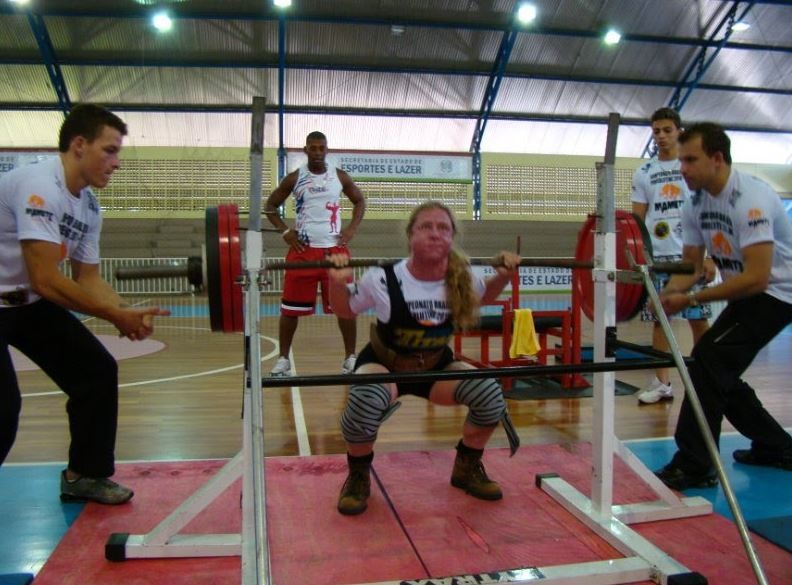
The “epic fail” knee wrap use meet. This was the first attempt, the wraps are in place and not really tight. They came off on the third attempt. Vitória, Brazil, around 2008.
There are many different elastic materials from which wraps are made. When I have to wrap myself alone, I choose one wrap: it’s tough enough, but also elastic enough for me to handle different levels of tension according to the weight on the bar. When I competed wrapped or equipped, if I knew I had a handler (rare), then I would choose the wrap that was both ideal for me and something he could handle the pulling-and-wrapping part. Usually, it was a tougher wrap.
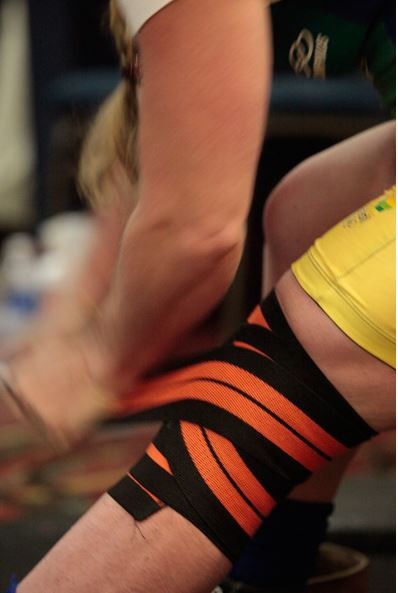
Atlanta 2011: me, wrapping myself for the first attempts.
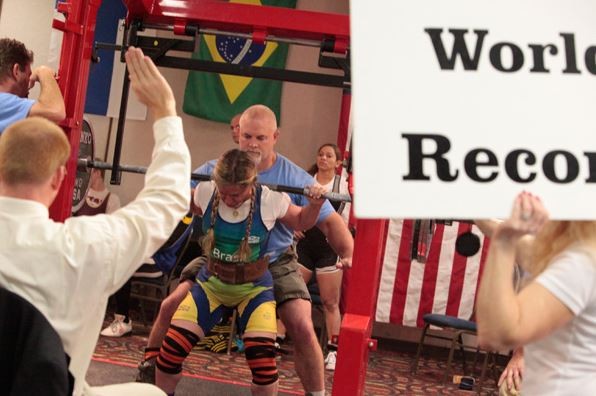
Atlanta 2011, when I broke the all-time record having been wrapped by a friend, Colombian coach Saul Salazar.
Competition Wrist Wraps Specifications:
Olympic Weightlifting
According to the International Weightlifting Federation, both knee and wrist wraps fall into the category of “bandages”.
Olympic weightlifters either didn’t use anything on their knees or they used medical bandages. Today, many competitors prefer knee sleeves but some still use wraps. However, they are not the same wraps used by powerlifters:
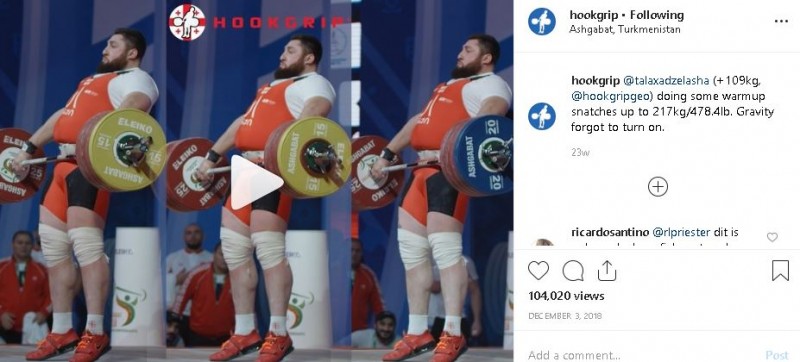
Lasha Talaxadze at the World Weightlifting Championship – 2018. Credit: Hookgrip
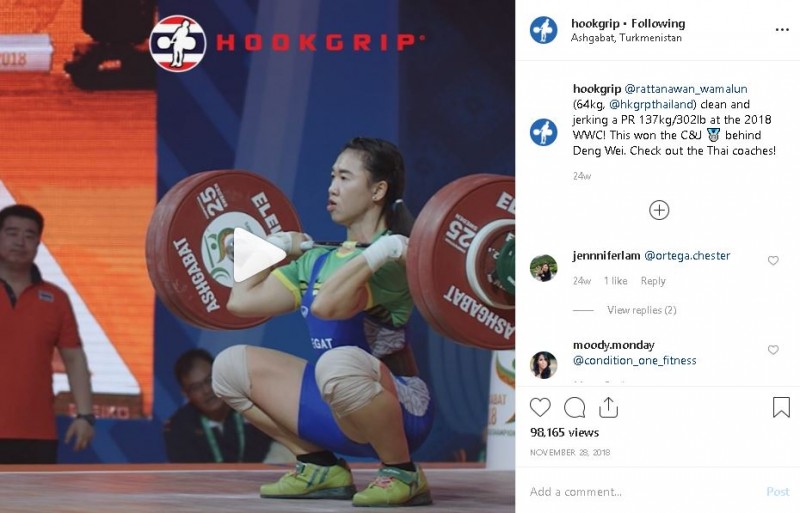
Raattanawong Wamalun at the World Weightlifting Championship – 2018. Credit: Hookgrip
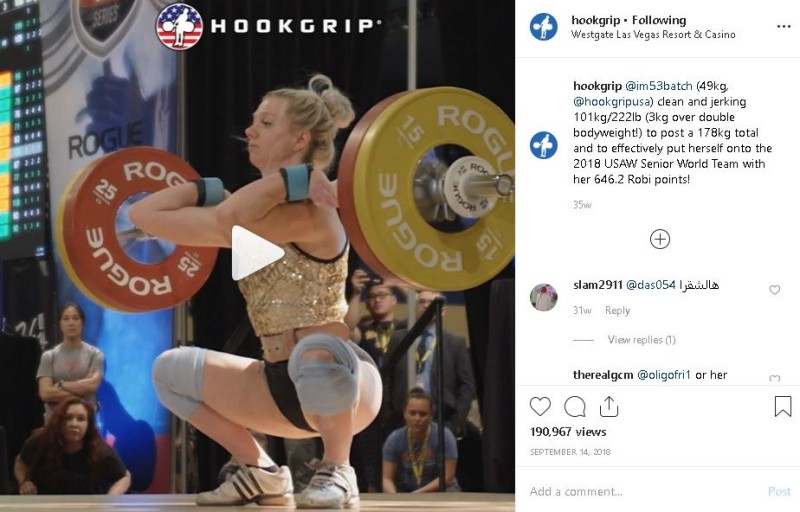
Cortney Batchelor – Westgate Las Vegas Resort & Casino – 2018. Credit: Hookgrip
Powerlifting
According to the International Powerlifting Federation, the specifications are much stricter than for Olympic Weightlifting. Besides the specifications, the IPF and few other powerlifting organizations have a list of approved manufacturers that pay a registration and annual fee for each approved item. Other powerlifting sanctioning bodies do not have such manufacturer approval restriction but the rules concerning specifications vary only slightly (some federations allow wraps as long as 2.5m or even 3m).


Knee wraps can be wrapped in many different ways: spiral, crossed, outward, inward or any other variation. In powerlifting, consistency is important. I only wrap my knees inward and the only time I let someone wrap it outward I had a complete fracture of the right fibula during the descent on the squat. That’s me: my structure calls for an inward wrapping technique. Most lifters prefer it outward. Once a lifter has chosen their preferred way of wrapping themselves or being wrapped, it is important to do it exactly that way on competition day. Changing the wrapping technique on competition day can be harmless, detrimental to performance or totally disastrous. If a competitor gets a new handler on competition day, a good rule of thumb is to rehearse one’s preferred knee wrapping with him before the squat round.
Usually, knee wraps are rolled before wrapping a knee either manually or with devices manufactured for that purpose. Some people (see Brandon Lilly’s video below) prefer “free wraps”.
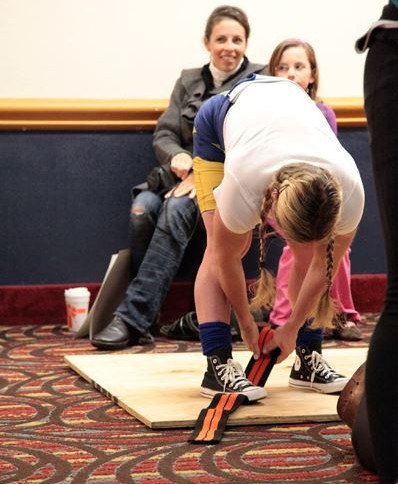
Atlanta 2011: rolling my wraps.
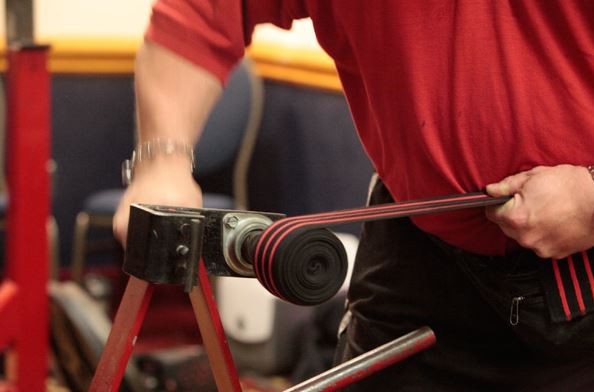
Atlanta 2011 (same meet): someone using the wrap-rolling machine.
Some examples of knee wrapping technique:
Eric Lillibridge (outward):
Chris Duffin (outward):
Brandon Lilly (inward):
Critical Bench (inward):
Me (inward: in Portuguese, two old videos, so just turn off the sound, skip the explanations you won’t understand and watch them – both done with soft wraps to illustrate technique):
The Strongman Corporation doesn’t provide technical specifications for knee wraps allowed in competition.
Here are some models carried by elitefts.
Precursors and Technological Innovation Pathways
The precursors of athletic knee wraps are medical knee wraps. In fact, not only they still exist (see here, here and here) but there is a much wider variety of medical knee wraps, wraps with braces, wraps with sleeves than athletic knee wraps. As shown before, weightlifters seem to use whatever they want, including medical bandages.
There is no way of dating when bandages started to be used for therapeutic purposes but it was probably in ancient times. The first books on surgery and orthopedics already show the use of bandages (Ponseti 1991, Coates ed. 1957).
Weightlifters used bandages to lift since the early days. Some of the best pictures have been published by Bruce Klemens and Weightlifting historian Arthur Chidlovski.
There are over 35,000 orthopedic bandage patents and over 450,000 medical bandage patents. The patenting activity started around the 1950s and peak between 2007-2013 on both search terms (orthopedic and medical bandages). It is unclear whether this is a by-proxy indicator of industrial competitive activity or actual technological innovation. Johnson & Johnson is the top patent owner (“assignee”) with 1.6% of total orthopedic patents. Lifters’ old-time (and still) favorite, ACE has a hundred years history of bandage manufacturing and invention.
The State of the Art
There is negligible research on knee wrap effect on the squat. Ironically, one of the two relevant studies was the first one to be published (Harman & Frykman 1990). The study used a harness to lift the experimental subjects and measure vertical forces during the squat with or without knee wraps.
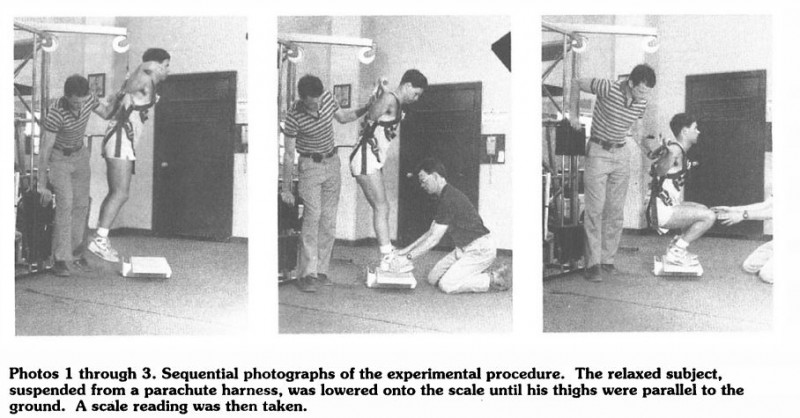
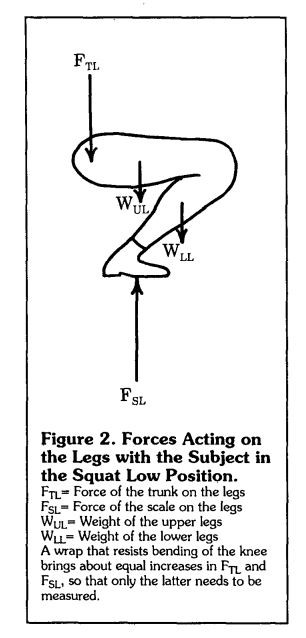
Wrapping technique was carefully documented and explained:
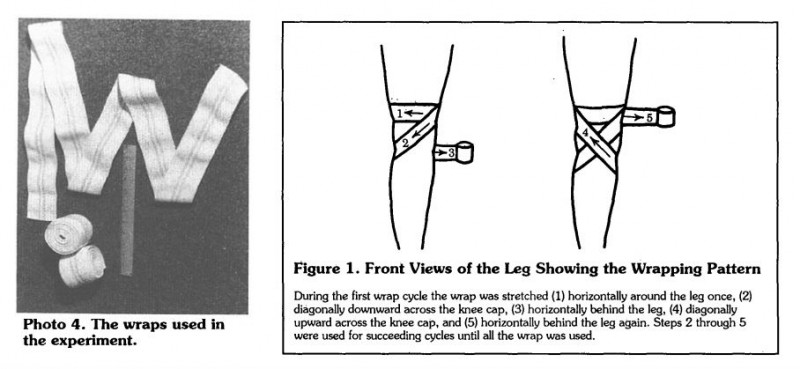
The authors concluded that wearing the wraps significantly increased the vertical force at the feet by 25.1 +/- 5.9lbs: “The experiment revealed direct mechanical assistance by wraps great enough to affect the outcome of a powerlifting squat”. Through calculations using estimates of the center of mass location of each of the body segments in the squat low position, the knee wrap angle relative to the leg and the moment arm around the knee through which the wraps work, they concluded that a total of 75lbs of total wrap tension per leg was required to produce the observed added force of 25lbs.
The authors add their perspective on tight knee wrap use (as is done in powerlifting) for the squat on a negative tone, suggesting it is potentially harmful and may lead to injury. They also quote USWF orthopedist Richard T. Herrick who observed an association between very tight knee wraps and chondromalacia patellae.
Another pioneering article (Totten 1990) explains the obvious observation by anyone familiar with heavy squats and surprisingly ignored by a few subsequent studies: the wraps are one of the external resistances during a wrapped squat. The knee flexes against the wraps, the elastic material is stretched during the eccentric phase, accumulating potential energy which is transferred back as added kinetic energy during the concentric phase. Totten also warns against the injury risks of forcing the patella to an inward position during the squat.
Other studies ignore those basic facts concerning the squat with wraps and their conclusions are either questionable or too specific and hardly applicable to the real-life wrapped squat. Flaws include testing the squat only to parallel position, extrapolating isometric measured forces to full range of motion squats, bodyweight wrapped squats (which, as we know, are done against the resistance provided by the wraps), not normalizing wrapping technique, among others (Eitner et al 2011, Gomes et al 2014). Other studies’ conclusions add nothing or not much to what was already stated in previous works (Marchetti et al 2015, Freitas et al 2018, Godawa et al 2012).
In 2012, Lake and collaborators conducted a well-controlled study comparing wrapped and non-wrapped squats and concluded that “mechanical work involved in vertically displacing the center of mass was performed 20% faster and was reflected by a 10% increase in peak power” but “altered back squat technique in a way that is likely to alter the musculature targeted by the exercise and possibly compromise the integrity of the knee joint”.
The mechanism of action is still unclear. Another approach to understanding the effect of the knee wrap is looking at squat biomechanics. That was the approach I adopted (Coutinho 2011).
The main forces involved in the squat affecting the knees are the posterior cruciate ligament (PCL) tensile forces, anterior cruciate ligament (ACL) tensile forces, tibiofemoral (TF) compressive forces and patellofemoral (PF) compressive forces. All such forces are increased with increased knee flexion (Escamilla et al 2001) and further augmented under external resistance (Wallace et al 2002). Particularly, TF and PF tend to assume greater values with increased knee flexion (Escamilla 2001).
Squat stance also alters the forces operating on the lifter’s body. A wider stance tends to increase the movement on both hip and knee joint, thus aggravating the PF/TF augmentation (Escamilla et al 2001b).
Senter and Hame (2006) looked at knee flexion angle. According to the authors, there are many knee injuries in sports in general associated with hyperflexion of the knee joint. At such angles, PCL and meniscus are usually compromised. PCL deficient knees exhibit greater external tibial rotation, which is also detrimental to joint integrity. The authors concluded by suggesting that a piece of protective equipment could reduce the forces over PCL, ACL, and meniscus. Along with appropriate, proper training and safe surfaces, they could help to prevent injuries.
A tight, compressive knee wrap as used by powerlifters alters those forces which translate in a different movement pattern (technique). This is probably what Lake and collaborators observed. Whether they contribute to injury or help prevent them is unclear and more research is needed.
How Do Athletes Use the Knee Wrap: The Survey
I created a survey about knee wrap use for athletes and regular weight training people. There are 197 responses, the great majority of which being from powerlifters. The majority of respondents (92.7%) feel the wraps improve their performance, while 43.5% feel they protect them from injury and 51.6% feel there is a gain in stability. Also, 68.5% declared they use the wraps to lift heavier weights while 35.2% use them for injury prevention and 25.9% use because they already have an injury. These were multiple, non-exclusive option questions.
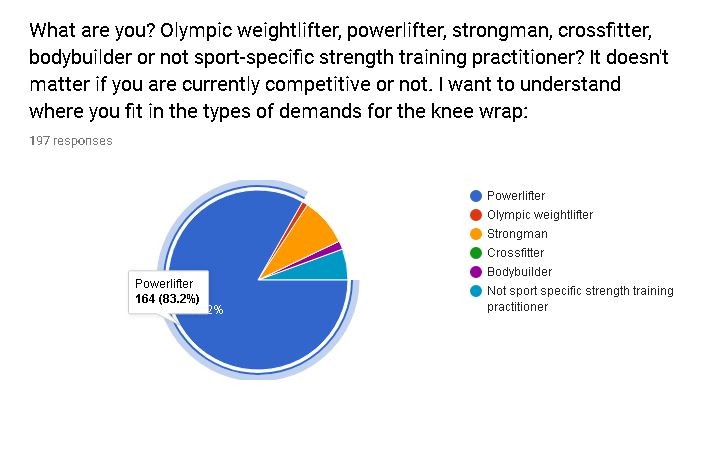
Respondents were fairly well distributed between sex and age groups, with a prevalence of males and a concentration between mid-twenties to late thirties:

Among respondents, only approximately half of them still use knee wraps. Almost 30% never used them and 17.3% no longer use them. The most frequently alleged reasons for not using knee wraps any more are:
- Switched to a different sport (strongman or bodybuilding)
- Stopped squatting (usually due to injury)
- Time-consuming in training
- Difficult to find a handler in competition
- No equipped competition in their area
- Tried the wraps but they felt uncomfortable and spoiled their squat
The number of raw powerlifting meets has increased many-fold in the past two decades and as we can see, a large number of lifters are wrapped by their handler in competition. This is usually done to spare the lifter the strength needed to wrap himself and also to ensure a better and tighter wrapping by the handler. Those that compete without a handler may have boarded the raw train and stayed there. Observe the percentage of athletes who depend on a handler to wrap them in competition:
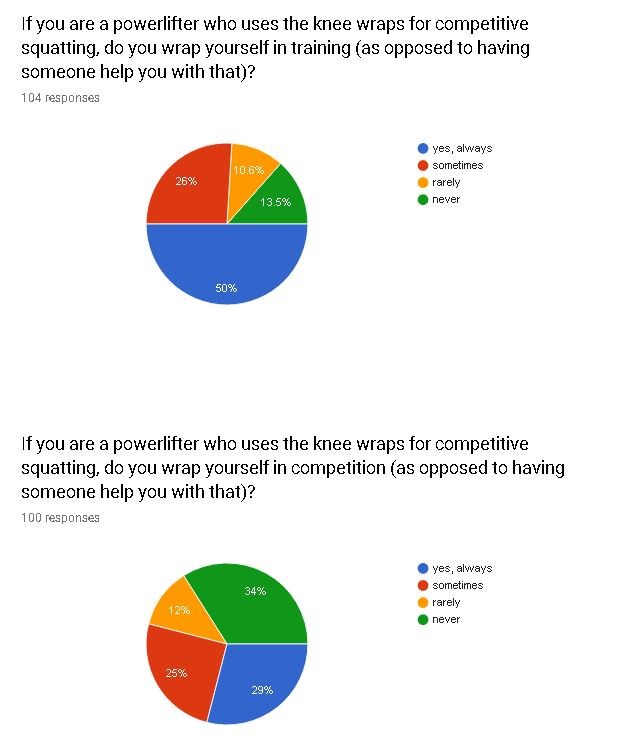
Consistent with the competitive use of the knee wraps, most respondents only wear the equipment during competitive preparation. A non-negligible percentage (34.7%) uses them year-round, possibly because they participate in several competitions every year.
Wraps are usually introduced in a training session after a longer warm up with lighter weights. Lifters start wrapping themselves usually when they hit around 80% (of 1RM) intensity:
The majority of lifters prefer their knees wrapped outward (see videos above):
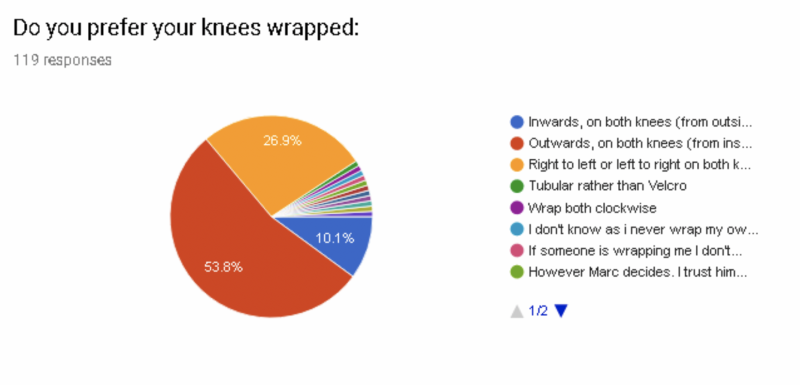
The big question of how much lifted weight the knee wrap adds to the raw squat has not been answered by research. The self-perception of lifters is close to the average difference in all-time record squats between with-wraps and no-wraps. Still, these numbers must not be taken as anything more than what they are: a comparison of world records. This is not a well-conducted experiment controlling for all possible variables.
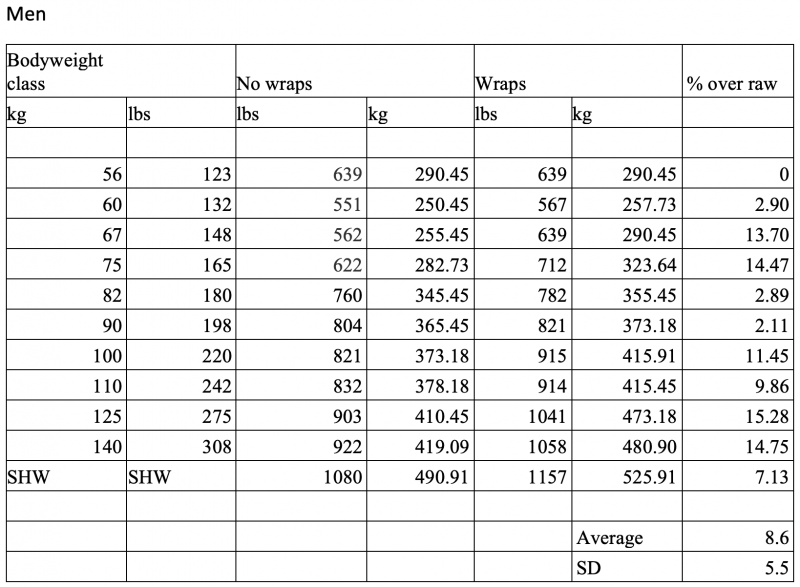
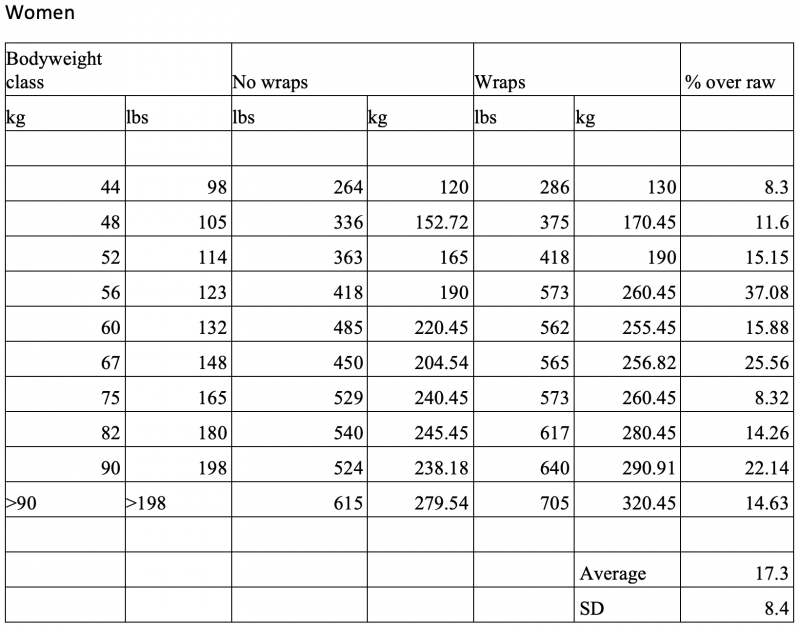
Finally, for powerlifters, knee wrap length and manufacturer choice depend less on their preference than on the sanctioning body’s rules and approved equipment. The federation with the highest number of competitors, the IPF, sets at 2m the length limit of allowed knee wraps. Consistent with this, 44.6% of the survey’s respondents used 2m wraps. All other federations allow longer wraps: 47.9% of respondents use 2.5m wraps and 28.1% use 3m wraps.
Can the Systematic Use of a Knee Wrap Cause Muscle Weakness?
As we will discuss further concerning other supportive gear, with the changes in movement pattern caused by the equipment there will be physiological strength adaptations. Although not adequately researched, all supportive equipment provide support from lift-off through sticking point, but not on lockout. Elite equipped lifters are adapted to equipped lifting.
Anecdotal evidence suggests that for a raw lifter, a season of equipped lifting causes loss on the raw maximum lifted weight. It means that since the full range of motion includes all stages of the lift, the adaptations that took place during the equipped season caused a net loss for the raw lift, easily reversible.
It is, however, intuitive that before introducing the use of any equipment, the lift is properly mastered and skill becomes automatic.
Takeaways
Bottom line: “know thyself” (again).
References
- Coates, John Boyd, ed. Orthopedic surgery in the Mediterranean theater of operations. Office of the Surgeon General, Department of the army, 1957.
- Coutinho, M. "De volta ao básico: Powerlifting." São Paulo: Phorte (2011).
- Eitner, J. D., R. G. LeFavi, and B. L. Riemann. "Kinematic and kinetic analysis of the squat with and without knee wraps." The Journal of Strength & Conditioning Research 25 (2011): S41.
- Escamilla, RAFAEL F. "Knee biomechanics of the dynamic squat exercise." Medicine & Science in Sports & Exercise 33, no. 1 (2001): 127-141.
- Escamilla, Rafael F., Glenn S. Fleisig, N. A. I. Q. U. A. N. Zheng, Jeffery E. Lander, Steven W. Barrentine, James R. Andrews, Brian W. Bergemann, and CLAUDE T. MOORMAN III. "Effects of technique variations on knee biomechanics during the squat and leg press." Medicine & Science in Sports & Exercise 33, no. 9 (2001): 1552-1566.
- Escamilla, Rafael F., Glenn S. Fleisig, Tracy M. Lowry, Steven W. Barrentine, and James R. Andrews. "A three-dimensional biomechanical analysis of the squat during varying stance widths." Medicine and science in sports and exercise 33, no. 6 (2001): 984-998.
- Freitas, Fábio Sisconeto de, Willy Andrade Gomes, and Paulo Henrique Marchetti. "Effects of elastic wrap on muscle activity and isometric force of knee extensors." Revista Brasileira de Medicina do Esporte 24, no. 4 (2018): 295-299.
- Godawa, Travis M., Daniel P. Credeur, and Michael A. Welsch. "Influence of compressive gear on powerlifting performance: role of blood flow restriction training." The Journal of Strength & Conditioning Research 26, no. 5 (2012): 1274-1280.
- Gomes, Willy Andrade, E. P. Serpa, Enrico Gori Soares, Josinaldo Jarbas da Silva, D. A. Corrêa, Fernando Henrique Domingues de Oliveira, Francisco de Abreu Neto, Gustavo Martins, G. B. Vilela Junior, and Paulo Henrique Marchetti. "Acute effects on maximal isometric force with and without knee wrap during squat exercise." Int J Sports Sci 4, no. 2 (2014): 47-9.
- Harman, Everett, and Peter Frykman. "BRIDGING THE GAP—RESEARCH: The effects of knee wraps on weightlifting performance and injury." Strength & Conditioning Journal 12, no. 5 (1990): 30-35.
- Lake, Jason P., Patrick JC Carden, and Kath A. Shorter. "Wearing knee wraps affects mechanical output and performance characteristics of back squat exercise." The Journal of Strength & Conditioning Research 26, no. 10 (2012): 2844-2849.
- Marchetti, Paulo Henrique, Viviane de Jesus Pereira Matos, Enrico Gori Soares, J. J. Silva, E. P. Serpa, Daniel Alves Corrêa, Gustavo Martins, G. B. Vilela Junior, and Willy Andrade Gomes. "Can the technique of knee wrap placement affect the maximal isometric force during back squat exercise." Int J Sports Sci 5, no. 1 (2015): 16-8.
- Ponseti, Ignacio V. "History of orthopaedic surgery." The Iowa orthopaedic journal 11 (1991): 59.
- Senter, Carlin, and Sharon L. Hame. "Biomechanical analysis of tibial torque and knee flexion angle." Sports Medicine 36, no. 8 (2006): 635-641.
- Totten, Leo. "Bridging The Gap—practical Application: Knee wraps." Strength & Conditioning Journal 12, no. 5 (1990): 36-39.
- Wallace, David A., George J. Salem, Ruben Salinas, and Christopher M. Powers. "Patellofemoral joint kinetics while squatting with and without an external load." Journal of Orthopaedic & Sports Physical Therapy 32, no. 4 (2002): 141-148.












